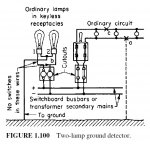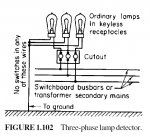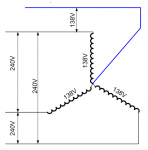I can’t seem to find a good image of how ground fault lighting detectors are wired, anybody got any good pictures or references?

212. Ground detectors for two-wire dc circuits. Figure 1.100 shows a very good
and simple detector for any two-wire low-voltage system. The lamps for the detector
should each be of the same wattage and voltage, the voltage being about the same as that
of the regular lamps in the plant, and two lamps which, when connected in series, burn with
equal brilliancy should be selected. Although somewhat greater sensitiveness can be
obtained with low-wattage lamps, such as 25-W lamps, for example, it is believed in general
to be better to use lamps of the same wattage as those throughout the plant, because a
burned-out or broken detector lamp can then be immediately replaced by a good lamp from
the regular stock, thus avoiding the necessity of keeping on hand a few spare special lamps.
The detector lamps, being two in series across the proper voltage for one lamp, burn
only dimly. If, however, a ground occurs on any circuit, as at a, the current from the positive
busbar through lamp 1 divides on reaching b instead of all going through lamp 2, as it
did when there was no ground. Part now goes down the ground wire and through the ground
to a, as indicated by the broken line, and thence through the wires to the negative busbar.
This reduces the resistance from b to the negative busbar, and therefore more current flows
through lamp 1 than before, while less current flows through lamp 2. Lamp 1 consequently
brightens, and lamp 2 dims. If the ground had occurred at c instead of a, lamp 2 would have
brightened and lamp 1 would have dimmed.
Attention is called to the following points, which are frequently neglected in this form
of detector:
1. The lamp receptacles should be keyless, and there should be no switches of any kind in
any of the connecting wires, so that the detector will always be in operation. To be of
greatest value, the detector must give indications instantly when a ground occurs. The
observer should not have to wait until the engineer or electrician remembers to close a
switch.
2. The wires should be protected by small fuses where they connect to the busbars. If these
fuses are omitted, a short circuit across these wires would either burn up the wires or
blow the main generator fuses.
3. The lamps should be placed very close together, within 1 or 2 in of each other if possible.
The farther apart they are, the harder it is to detect any slight difference in brilliancy
between them.
4. The ground wire should be carefully clamped to a pipe which is thoroughly connected
to the ground, or some other equally good ground connection should be provided.

215. Ground detectors for ordinary low voltage three-phase ac circuits. A lamp detector connected as in Fig. 1.102 can be used.
The indication is the same as that with the lamp detectors described above. Thus, when a ground comes on one wire,
the lamp attached to that wire dims and the other two lamps brighten. The NEC® now requires ground detectors on ungrounded ac systems.
To meet this market there are now listed, self contained ground detectors available that are considerably more reliable than incandescent
lamps.
However, an understanding of how the lamp system works is important because there are untold thousands of such detection systems still in use.


